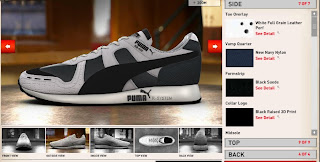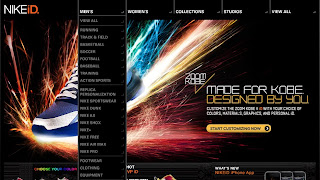The Digital Age has once again proved to be amazing. As companies’ internet marketing shifts from mass production toward the concept of mass customization, each and every one of us can (as Burger King puts it) “have it our way”. We can customize our Dell computers then order specially recommended books and music from Amazon.com. Then we can customize our shoes on the internet and walk into the future with one-to-one and mass customization marketing offered by so many companies today.
As a company focuses on a customer’s specific needs, the company can truly individualize its product. This means less emphasis on mass production to the numerous options and styles a customer might prefer. And so this is what Nike and Puma both achieved, respectively with their NikeID and the Puma Mongolian Shoe BBQ websites.
Compare and Contrast: Nike vs. Puma
Starting with the NikeID, the first screen proves this is a global phenomenon that’s connected via the internet. To make things easy, I chose to customize my shoe in the English language. The website is colorful and incredibly intense. As Nike is often perceived for the sportsperson, the website caters from running shoes to action sports shoes, which can be used in sports such as skateboarding, for both men and women. The website is very interactive and very futuristic looking in general with its metallic background and high tech buttons to press. The impression that I get from the NikeID is they’re very serious about giving the consumer a shoe fit exactly for the consumer’s chosen activity or lifestyle, while adding the specific flair the consumer wishes to wear. On first glance, the options that Nike’s site offers is almost overwhelming.
I had almost too many options, which is impressive
On the other hand, Puma’s website seems lighthearted when compared to the Nike website. The website starts with a quick tour of a restaurant and then gives a menu to engage the consumer’s creative side. The consumer isn’t exposed to a very serious first approach like Nike chose, but a more fun and kind of humorous fashion. By giving the consumer a digital “chef’s hat”, he or she can begin to design the desired shoe with three blank pre-styled shoes that are not for specific sports or lifestyles. Unlike Nike, Puma gives the consumer a few “laid back” or casual shoes that are not terribly specialized for a specific sport or activity. Overall, NikeID’s website exudes a very serious, specialized shoe for a serious athlete with some spare money to spend. This will appeal to consumers who are highly involved in their sport of choice. Puma’s approach gives the idea that the consumer doesn’t need to be a star basketball player to wear Puma shoes, but he or she has the ability to add a custom spice to make the shoe his or her own shoe for many occasions.
My First-Hand Customer Experience
On Nike’s website, I browsed through the extensive variety of athletic shoes that I was able to design. I went with a running shoe, since I often run. As I previously mentioned, at first I was a bit overwhelmed by the choices, colors, designs and everything else the flashy website bombarded me with. Once I got my bearings back and began designing, the process was fairly simple, though I feel Nike can make it even simpler for less tech savvy consumers. Nike certainly used advanced technology to display my custom shoe throughout the process by offering multiple angles of the shoe at any time. Clicking and dragging the shoe image allowed me to view even more angles that the pre-selected views didn’t offer. Along with different angles I could zoom in and out with quality images of the shoe. The design process was especially interactive by letting me click on the exact part of the shoe I want to change, whether it was color or type of sole depending on what surfaces I’d mainly run on. Once I finished, I had the option to imbed the image of my custom shoe on Web 2.0 websites, such as facebook and twitter, so I can show the world my personally designed Nike shoe…all because of mass customization.
The Puma website was easier to begin designing the shoe with three clear options of the desired style. While this approach is simpler and less difficult to use, it does have its limitations. One limitation included Puma’s inability to see every possible angle, like Nike offered. However, like Nike, Puma’s website gave you a step by step guide to choosing colors and materials for each bit of the shoe. The technology on Puma’s website was easily satisfactory, but it didn’t quite have the standard Nike adopted, which I would consider a competitive advantage on Nike’s behalf. Puma didn’t engage me on the level Nike was able to. Overall, Puma’s website technology was simpler and easier to use than Nike’s, but it was also less impressive. The concept of the Puma site was interesting, as it cited the history of a Mongolian BBQ and how everybody has his or her own tastes and preferences. This shows Puma’s desire to practice mass customization by using the internet’s technologies and capabilities.

Easier to use, but less impressive
While both companies are certainly willing to charge a premium for every consumer’s custom taste, the idea of mass customization is interesting. These companies won’t enjoy the pleasures of buying and selling in economies of scale, but it demonstrates the companies’ ability to adapt to ever-changing technology. As Web 2.0 shows, the consumer is empowered by collaborating with the company to design a shoe. The consumers can then later post it on their social networking pages and share a personally created shoe with the entire world, which is a great example of companies utilizing Web 2.0 technologies in the Digital Age for everyone’s advantage.
Coming to stores in Spring of 20-NEVER, the brand new Nike Running shoe cleverly deemed: The “SCOTTW”

